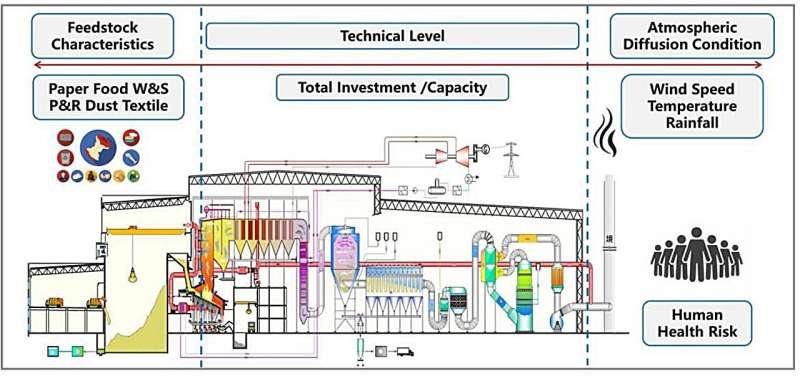This article has been reviewed according to Science X's editorial process and policies. Editors have highlighted the following attributes while ensuring the content's credibility:
fact-checked
proofread
Study declares waste-to-energy plants a low health risk

As China rapidly urbanizes, turning waste into energy has become a key way to handle growing trash volumes and reduce landfill use, while also creating power. Yet, concerns about the pollution from these plants and its health effects have led to debates. Making sure these plants use the best technology to control pollution is crucial for protecting air quality and health, emphasizing the need for ongoing improvements and careful health checks.
A recent study published in Eco-Environment & Health in February 2024 has unveiled the minimal health risks associated with emissions from waste-to-energy (WtE) plants in the Bohai Rim, China. The research team from Tianjin University, offers new insights into the impact of WtE emissions on public health using advanced regression analysis.
The study embarked on an innovative path by integrating atmospheric modeling tools with health risk assessment methods to scrutinize the impact of emissions from 96 WtE facilities across the Bohai Rim region. Researchers employed the Weather Research and Forecasting model and the California Puff (CALPUFF) model to predict how pollutants disperse in the atmosphere, focusing on key contaminants such as dioxins, furans, and particulate matter.
By comparing the concentration of these pollutants in the environment against health safety benchmarks, the team calculated Hazard Indices (HI) and Carcinogenic Risks (CR) to estimate potential health impacts on nearby populations. Remarkably, their findings revealed that the levels of these pollutants were below international safety thresholds, suggesting that the health risks associated with living near WtE plants are low.
Inhalation health risks from the Bohai Rim's WtE plants were evaluated. Determinants of incineration health risks and their correlations were investigated using ridge regression method. Hazard indices (HI) in January and July were 4.07 × 10−3 and 1.82 × 10−3, respectively. Cancer risks (CR) in January and July were 4.72 × 10−7 and 2.13 × 10−7, respectively.
Health risks from WtE plants can be reduced through municipal solid waste (MSW) classification. The findings can serve as useful guidelines for law enforcement wings and industry professionals seeking to minimize the risks associated with MSW management and promote sustainable development.
"The findings challenge the traditional apprehension regarding WtE emissions, highlighting the effectiveness of current pollution control technologies," says Wenchao Ma, lead researcher of the study. "This underscores the importance of technological advancement and stringent operational standards in mitigating health risks."
This research is innovative, blending environmental science with public health to offer comprehensive insights. It provides crucial, evidence-based guidance for policymakers, environmental agencies, and WtE operators, aimed at enhancing waste management strategies.
More information: Zhuoshi Huang et al, Health risk assessment of municipal solid waste incineration emissions based on regression analysis, Eco-Environment & Health (2024). DOI: 10.1016/j.eehl.2024.01.009
Provided by TranSpread





















